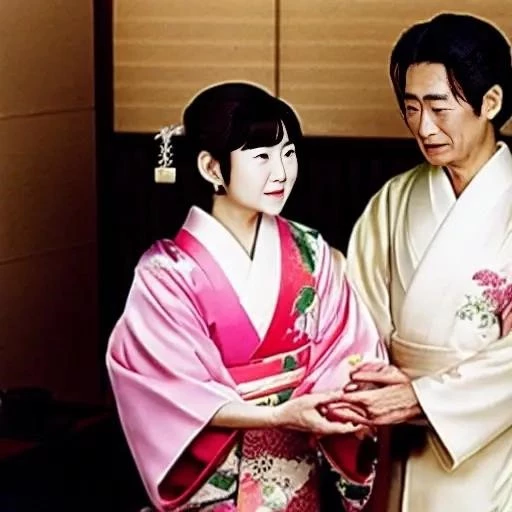
Have you ever found yourself scrolling through streaming platforms, desperately searching for a show that truly grabs you? Something that isn’t just entertainment, but a mirror reflecting complex human emotions and difficult choices? Well, if you’re a fan of compelling storytelling, especially from the vibrant world of Japanese dramas, then you might have already stumbled upon, or at least heard whispers about, a series that’s been making waves: ‘Take My Husband To Bed’ Japanese Drama. It’s not just a catchy title; it’s an invitation into a world where relationships are tested, and the lines between right and wrong blur in the most captivating ways.
Unpacking the Buzz: What is ‘Take My Husband To Bed’ Japanese Drama All About?
Let’s be honest, the title alone, ‘Take My Husband To Bed’ Japanese Drama, immediately suggests a certain level of intrigue, doesn’t it? And trust me, the series lives up to that promise. This isn’t your typical light-hearted romance; instead, it delves headfirst into the messy, often painful, realities of modern relationships, infidelity, and the emotional fallout that comes with betrayal.
The story often centers around characters like Kanzaki Miwa, a full-time housewife married to Kanzaki Hiroki. She made the tough decision to leave her corporate job, a choice many can relate to, only to face a different kind of challenge at home. The drama isn’t afraid to explore the raw emotions of women dealing with partners who stray, or even their own impulsive actions born from heartbreak. It asks us to consider: What happens when the person you trust most shatters your world? And what lengths might someone go to when pushed to their emotional limits?
Pro Tip: Japanese dramas, or Jdramas, are renowned for their ability to tackle sensitive subjects with nuance and a focus on character development. If you appreciate deep psychological exploration, this genre is a goldmine!
Key Themes Explored in ‘Take My Husband To Bed’ Series:
- Marital infidelity and its consequences.
- The emotional toll of betrayal on individuals and families.
- Impulsive decisions made under emotional duress.
- The complexities of trust and forgiveness.
- Societal expectations placed on housewives and partners.
These themes are woven into a narrative that keeps you guessing, making you empathize with characters even when their choices are questionable. It’s a true emotional rollercoaster, leaving you pondering long after the credits roll.
Finding Your Way: Where to Stream ‘Take My Husband To Bed’ Jdrama
So, you’re intrigued, right? You want to know where you can immerse yourself in the world of ‘Take My Husband To Bed’ Jdrama. Good news! This short but impactful series is primarily available on the Bump App; Yes, that’s right, the Bump App seems to be the go-to platform for catching all the intense episodes.
Many viewers have been asking if they can watch it for free. While some platforms offer free trials or ad-supported content, the most reliable way to access the full series, especially given its recent buzz, is often through a subscription or direct access on the Bump App. It’s always worth checking the app’s current offerings and any regional restrictions, as these can sometimes vary. Don’t you just hate it when you find a gem only to discover it’s not available in your region?
Viewing Tip: Always check the official app or streaming service directly for the most accurate and up-to-date information on availability and pricing. Sometimes, a quick search on their website can save you a lot of hassle!
The beauty of these shorter Jdramas is their accessibility. You can often binge-watch an entire series in a weekend, making it perfect for those who don’t want to commit to a 20-episode saga. It’s a compact, potent dose of drama that gets straight to the heart of the matter.
Beyond the Title: The Emotional Depth of ‘Take My Husband To Bed’ Series
Beyond the provocative title, ‘Take My Husband To Bed’ series offers a surprisingly deep dive into the human psyche. It explores the myriad ways people react to heartbreak and betrayal. We see characters grappling with the aftermath of a partner cheating with a co-worker, or even the unthinkable act of infidelity with a best friend’s husband. Can you imagine the sheer devastation?
The drama doesn’t shy away from showing the raw, unfiltered emotions: anger, confusion, sadness, and a desperate search for understanding or revenge. It makes you question what you would do in similar circumstances. Would you confront? Would you forgive? Or would you, like some characters, make an impulsive decision that changes everything?
This series resonates because it touches on universal fears and experiences. Who hasn’t felt the sting of betrayal or the temptation to act out when hurt? It’s a powerful reminder that life is rarely black and white, and human emotions are incredibly complex. The nuanced performances by the actors truly bring these struggles to life, making you feel every pang of their pain and every flicker of their hope.
Frequently Asked Questions About ‘Take My Husband To Bed’ Japanese Drama
Q: What is ‘Take My Husband To Bed’ Japanese Drama about?
A: It’s a Japanese drama that explores themes of marital infidelity, emotional betrayal, and the complex reactions of individuals, particularly women like Kanzaki Miwa, when faced with their partner’s unfaithfulness or their own impulsive choices.
Q: Where can I watch ‘Take My Husband To Bed’ for free?
A: The series is primarily available on the Bump App. While some platforms may offer free trials, direct free streaming might be limited. It’s best to check the Bump App directly for their current subscription or viewing options.
Q: Is ‘Take My Husband To Bed’ a long series?
A: No, it’s described as a “short Jdrama,” making it a perfect choice for those who prefer to binge-watch a complete story over a shorter period.
Q: Who is Kanzaki Miwa in the ‘Take My Husband To Bed’ series?
A: Kanzaki Miwa is a central character in the drama, a full-time housewife married to Kanzaki Hiroki. Her journey and emotional struggles are a significant part of the series’ narrative.
So, there you have it. ‘Take My Husband To Bed’ Japanese Drama isn’t just a show; it’s an experience. It’s a raw, honest look at the human heart, its capacity for both love and pain, and the difficult paths we sometimes find ourselves on. If you’re ready for a drama that will make you think, feel, and perhaps even question your own perceptions of relationships, then this might just be your next binge-watch. Give it a try, and prepare to be moved.
In the dynamic realm of contemporary Japanese television, certain productions transcend mere entertainment to become significant cultural touchstones. The short-form Japanese drama, often referred to as a Jdrama, titled “Take My Husband To Bed” has undeniably emerged as one such notable entry. This series, while compact in its episodic structure, delivers a potent narrative that meticulously dissects the intricate layers of marital infidelity, personal betrayal, and the profound emotional repercussions that ripple through the lives of its characters. Its compelling premise and unflinching exploration of human vulnerability have captured considerable audience attention, prompting a deeper analytical inquiry into its artistic merits and broader societal relevance. The drama’s ability to condense complex emotional arcs into a concise format underscores a growing trend in digital storytelling, offering viewers impactful narratives without the extensive commitment of traditional long-form series. This continuation aims to provide a professional and maximally formal analysis of this intriguing production.
Deconstructing the Narrative: The Artistic Merit of ‘Take My Husband To Bed’ Jdrama
The narrative construction of ‘Take My Husband To Bed’ Jdrama exhibits a sophisticated understanding of dramatic tension and character development, particularly within its abbreviated runtime. The series masterfully employs a non-linear or multi-perspective approach to unravel the intricacies of its central conflict, allowing for a more profound exploration of each character’s motivations and emotional states. This meticulous scripting ensures that the audience is not merely presented with a story of infidelity but is invited to delve into the psychological underpinnings of betrayal and its aftermath.
The portrayal of characters such as Kanzaki Miwa, a full-time housewife navigating the complexities of her marriage, is particularly noteworthy. Her journey from perceived domestic stability to emotional turmoil is depicted with a nuanced sensitivity that avoids simplistic villainization or glorification. Such character depth is a hallmark of high-quality dramatic writing, contributing significantly to the series’ critical reception.
Critical Observation: The concise format of ‘Take My Husband To Bed’ necessitates highly efficient storytelling. Each scene and dialogue exchange is meticulously crafted to advance the plot and deepen character understanding, a testament to the screenwriting team’s expertise.
Key Elements of Narrative Excellence in ‘Take My Husband To Bed’ Series:
- Psychological Realism: Characters exhibit credible emotional responses to challenging circumstances, enhancing viewer empathy.
- Pacing and Structure: The compact nature of the series ensures a rapid, engaging pace without sacrificing thematic depth.
- Subtle Symbolism: Visual and thematic elements are often employed to convey deeper meanings, enriching the viewing experience.
- Dialogue Nuance: Conversations are crafted to reveal character, advance plot, and hint at underlying tensions, rather than merely stating facts.
The production values, including direction and cinematography, further elevate the series. Visual storytelling techniques are adeptly utilized to mirror the internal states of the characters, employing specific color palettes, camera angles, and shot compositions to underscore moments of despair, reflection, or confrontation. This cohesive artistic vision contributes significantly to the overall impact of ‘Take My Husband To Bed’ as a distinguished piece of contemporary Japanese drama.






